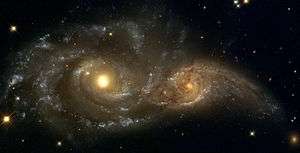NGC 2207 and IC 2163
| NGC 2207 / IC 2163 | |
|---|---|
|
| |
| Observation data (J2000 epoch) | |
| Constellation | Canis Major |
| Right ascension | 06h 16m 22.0s / 06h 16m 28.0s[1] |
| Declination | −21° 22′ 22″ / −21° 22′ 33″[1] |
| Redshift | 2741 ± 15 / 2765 ± 20 km/s[1] |
| Distance |
81 ± 39 Mly (24.9 ± 12 Mpc)[2] |
| Apparent magnitude (V) | 12.2 / 11.6[1] |
| Characteristics | |
| Type | SAB(rs)bc pec / SB(rs)c pec[1] |
| Apparent size (V) | 4′.3 × 2′.8 / 3′.0 × 1′.2[1] |
| Notable features | colliding galaxies |
| Other designations | |
| RR132a / RR132b,[1] PGC 018749 / 018751[1] | |
NGC 2207 and IC 2163 are a pair of colliding spiral galaxies about 80 million light-years away[2] in the constellation Canis Major. Both galaxies were discovered by John Herschel in 1835. The larger spiral, NGC 2207, is classified as an intermediate spiral galaxy exhibiting a weak inner ring structure around the central bar. The smaller companion spiral, IC 2163, is classified as a barred spiral galaxy that also exhibits a weak inner ring and an elongated spiral arm that is likely being stretched by tidal forces with the larger companion. Both galaxies contain a vast amount of dust and gas, and are beginning to exhibit enhanced rates of star formation, as seen in infrared images. So far, four supernovae have been observed in NGC 2207:
- type Ia SN 1975a in January 1975[3]
- type Ib SN 1999ec in October 1999[4]
- type Ib SN 2003H—discovered halfway between the two galaxies[5]
- type II supernova SN 2013ai in March 2013[6]
NGC 2207 is in the process of tidally stripping IC 2163.
Merging galaxies
NGC 2207 is in the process of colliding and merging with IC 2163. But unlike the Antennae or the Mice Galaxies, they are still two separate spiral galaxies. They are only in the first step of colliding and merging. Soon they will collide, probably looking a bit more like the Mice Galaxies. In about a billion years time they are expected to merge and become an elliptical galaxy or perhaps a disk galaxy.[7]
Gallery
-

An infrared Spitzer Space Telescope image of NGC 2207 and IC 2163. Credit: NASA/JPL.
-

An ESO image of NGC 2207 and IC 2163.
See also
References
- 1 2 3 4 5 6 7 8 "NASA/IPAC Extragalactic Database". Results for NGC 2207 / IC 2163. Retrieved 2006-11-25.
- 1 2 "Distance Results for NGC 2207". NASA/IPAC Extragalactic Database. Retrieved 2010-05-22.
- ↑ Kirshner, Robert P.; Arp, H.C.; Dunlap, J.R. (1976). "Observations of Supernovae - 1975a in NGC 2207 and 1975b in the Perseus Cluster". Astrophysical Journal. 207 (1): 44–52. Bibcode:1976ApJ...207...44K. doi:10.1086/154465.
- ↑ Jha, S.; Garnavich, P.; Challis, P.; Kirshner, R.; et al. (1999). "Supernova 1999ec in NGC 2207". IAUC. 7269: 2. Bibcode:1999IAUC.7269....2J.
- ↑ van den Bergh, Sidney; Li, Weidong; Filippenko, Alexei V. (2003). "Classifications of the Host Galaxies of Supernovae, Set II". The Publications of the Astronomical Society of the Pacific. 115 (813): 1280–88. arXiv:astro-ph/0308195
 . Bibcode:2003PASP..115.1280V. doi:10.1086/379106.
. Bibcode:2003PASP..115.1280V. doi:10.1086/379106. - ↑ Conseil, E.; Fraser, M.; Inserra, C.; Walton, N.; et al. (2013). "Supernova 2013ai in NGC 2207 = Psn J06161835-2122329". Central Bureau Electronic Telegrams (3431): 1. Bibcode:2013CBET.3431....1C.
- ↑ Junko Ueda; et al. "Cold molecular gas in merger remnants. I. Formation of molecular gas disks". The Astrophysical Journal Supplement Series. 214 (1). arXiv:1407.6873
 . Bibcode:2014ApJS..214....1U. doi:10.1088/0067-0049/214/1/1.
. Bibcode:2014ApJS..214....1U. doi:10.1088/0067-0049/214/1/1.
External links
| Wikimedia Commons has media related to NGC 2207. |
| Wikimedia Commons has media related to IC 2163. |
- HST: A grazing encounter between two spiral galaxies
- "NGC 2207". SIMBAD. Centre de données astronomiques de Strasbourg.
- "IC 2163". SIMBAD. Centre de données astronomiques de Strasbourg.
- NASA Astronomy Picture of the Day: Spiral Galaxies in Collision (19 January 2014)
